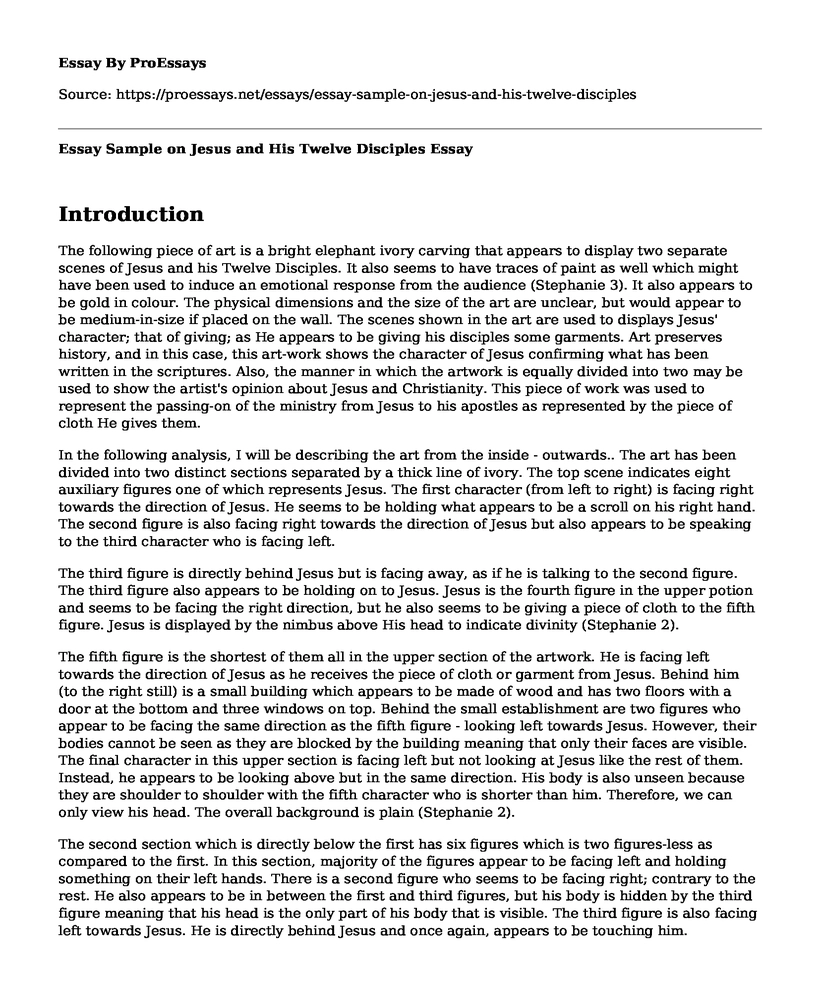Introduction
The following piece of art is a bright elephant ivory carving that appears to display two separate scenes of Jesus and his Twelve Disciples. It also seems to have traces of paint as well which might have been used to induce an emotional response from the audience (Stephanie 3). It also appears to be gold in colour. The physical dimensions and the size of the art are unclear, but would appear to be medium-in-size if placed on the wall. The scenes shown in the art are used to displays Jesus' character; that of giving; as He appears to be giving his disciples some garments. Art preserves history, and in this case, this art-work shows the character of Jesus confirming what has been written in the scriptures. Also, the manner in which the artwork is equally divided into two may be used to show the artist's opinion about Jesus and Christianity. This piece of work was used to represent the passing-on of the ministry from Jesus to his apostles as represented by the piece of cloth He gives them.
In the following analysis, I will be describing the art from the inside - outwards.. The art has been divided into two distinct sections separated by a thick line of ivory. The top scene indicates eight auxiliary figures one of which represents Jesus. The first character (from left to right) is facing right towards the direction of Jesus. He seems to be holding what appears to be a scroll on his right hand. The second figure is also facing right towards the direction of Jesus but also appears to be speaking to the third character who is facing left.
The third figure is directly behind Jesus but is facing away, as if he is talking to the second figure. The third figure also appears to be holding on to Jesus. Jesus is the fourth figure in the upper potion and seems to be facing the right direction, but he also seems to be giving a piece of cloth to the fifth figure. Jesus is displayed by the nimbus above His head to indicate divinity (Stephanie 2).
The fifth figure is the shortest of them all in the upper section of the artwork. He is facing left towards the direction of Jesus as he receives the piece of cloth or garment from Jesus. Behind him (to the right still) is a small building which appears to be made of wood and has two floors with a door at the bottom and three windows on top. Behind the small establishment are two figures who appear to be facing the same direction as the fifth figure - looking left towards Jesus. However, their bodies cannot be seen as they are blocked by the building meaning that only their faces are visible. The final character in this upper section is facing left but not looking at Jesus like the rest of them. Instead, he appears to be looking above but in the same direction. His body is also unseen because they are shoulder to shoulder with the fifth character who is shorter than him. Therefore, we can only view his head. The overall background is plain (Stephanie 2).
The second section which is directly below the first has six figures which is two figures-less as compared to the first. In this section, majority of the figures appear to be facing left and holding something on their left hands. There is a second figure who seems to be facing right; contrary to the rest. He also appears to be in between the first and third figures, but his body is hidden by the third figure meaning that his head is the only part of his body that is visible. The third figure is also facing left towards Jesus. He is directly behind Jesus and once again, appears to be touching him.
Jesus is the fourth character just as in the upper section of the artwork. In this section, he also appears to be handing out a piece of cloth to the fifth figure who is facing him. The fifth figure humbly accepts the piece of fabric, and stands in a manner that suggests humility. Behind him is another small structure made of stones with two windows above it and a large door. Behind the structure is another figure that appears to be facing in the right direction as if he is looking at Jesus (Stephanie 1).
The two sections are bound in a single thick frame which is also gold with flower-art surrounding the entire art-work. There are also minor details in the frame which makes it look three-dimensional. At each corner of the frame are four holes. Finally, the artist gives it a smooth edge to finish off the frame. The artwork is a true masterpiece indicating the passing of the ministry from Jesus to his disciples which is symbolically represented by the garments He gives his Apostles. It also displays the true nature of the Carolingian art form which focused on the use of ivory and other forms of art to demonstrate that which is found in the scriptures..
Works Cited
Thornton-Grant, Stephanie. "ART 101 Formal Analysis FA18". Prezi.Com, 2018, https://prezi.com/nhhavbs1bodp/art-101-formal-analysis-fa18/?utm_campaign=share&utm_medium=copy. Accessed 14 Dec 2018.
Cite this page
Essay Sample on Jesus and His Twelve Disciples. (2022, Nov 03). Retrieved from https://proessays.net/essays/essay-sample-on-jesus-and-his-twelve-disciples
If you are the original author of this essay and no longer wish to have it published on the ProEssays website, please click below to request its removal:
- Symbolism in Sonnet 67, 75 and 79 by Edmund Spencer
- Essay Sample on St. Paul's Academy
- Essay Example on Jesus: The King of Mercy and Authority
- Essay Sample on 13th: Slavery's Prolonged Legacy of Injustice
- Essay Sample on Exploring the Art of Suzhou Pingtan: Dance & Tsinghua
- Pornography's Impact on Modern Society: Examined - Essay Sample
- Rent 2008: A Tale of Love, Dreams and Reality - Essay Sample







